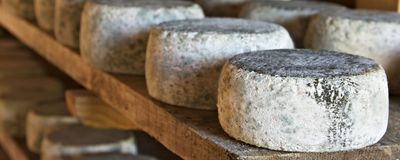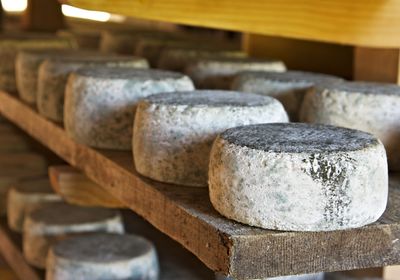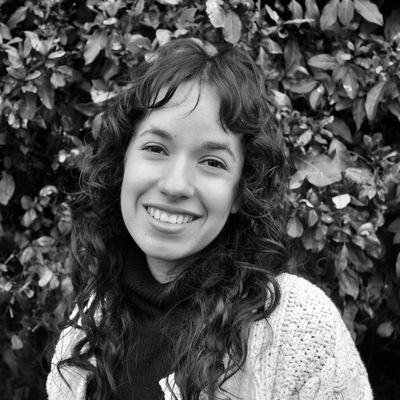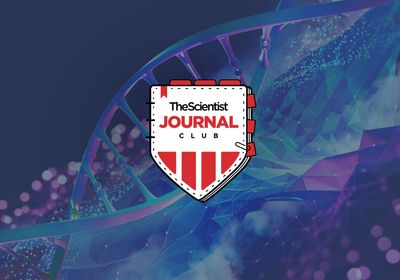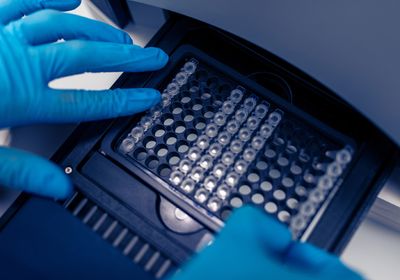ABOVE: Microbes help develop a rind on these aging asiago cheeses. © ISTOCK.COM, NIMU1956
Naturally aged cheeses like brie and some cheddars rely on microbes to develop a rind. This tough, sometimes fuzzy outside layer is often essential to a cheese’s funky taste, but unwanted molds can disrupt its formation. Now, researchers have identified a mold gene responsible for producing an antibiotic that disrupts rind-making bacteria, showing how a fungus can shape a microbiome. Recently published in mBio, the work suggests that science could help cheese-making artisans save their tasty products.1
Fungi release secondary metabolites that can influence bacterial growth, and sometimes they are exceptionally useful; the antibiotic penicillin is a famous example.2 But secondary metabolites from fungi can work against humans too, especially in cheese production, said microbiologist Nancy Keller from the University of Wisconsin, Madison, who coauthored the study.
The study started when a cheesemaker contacted Keller’s colleague, Ben Wolfe, a microbiologist at Tufts University, with the complaint that a fuzzy mold took over the bacterial communities on his natural-rind cheeses, like tomme, cheddar, and parmesan. Wolfe got a sample of the mold, which turned out to be a wild Penicillium species, a genus well known for making antimicrobial metabolites. He and Keller suspected that the fungus used one of these compounds to dominate the bacterial colonies on the cheese rind.
See also Can Mushrooms “Talk” to Each Other?
From previous studies, they knew that a regulatory gene called laeA controlled the expression of several secondary metabolite-producing genes.3 So, using a gene replacement strategy, the team created a wild Penicillium mutant lacking laeA. If the fungus used a secondary metabolite to curb bacterial growth, said Keller, “then by removing laeA, we should see a restoration of more normal growth of the bacteria. And that’s indeed what we saw.” Unlike the unmutated fungus, the mutant failed to overtake the bacterial communities when grown alongside them on the cheese.
They then zeroed in on the metabolites themselves. Using RNA sequencing on the laeA-free mutant, the team found that the lack of laeA decreased the expression of psoA, a gene controlling the production of a secondary metabolite called pseurotin. Thinking that this compound might have antibiotic functions, they used CRISPR-Cas9 to create another mutant lacking psoA to test pseurotin’s effect. In this case, “the bacteria were happy as can be and grew normally,” said Keller.
See also Cancer-like Slime Mold Growth Hints at Multicellularity’s Origins
The researchers don’t yet know how the fungus invades the microbial community, but they suspect that this pseurotin metabolite is an important player in the process. “This is probably the first time that an experiment . . . has shown that a fungal natural product was mediating the composition of the microbiome,” Keller said. “It’s telling us that the natural products of a fungus can totally change which organisms grow and don’t grow.”
“What was really cool about the study was the identification of a particular secondary metabolite involved in interactions,” said Antonis Rokas, an evolutionary microbiologist at Vanderbilt University Medical School who was not involved with the study. While researchers have suspected that fungi use chemicals to communicate with other microbial communities, examples of those interactions have been sparse so far.4 “[This study] shows the strength of fungi as a model system for genetics but in the context of a community… so how this particular fungus interacts with bacteria that colonize this particularly tasty environment.”
In the future, pinning down these fungal-bacterial interactions could help avoid or combat unwanted mold infestations. “Some of these contaminating fungi have natural products that could be just devastating to the bacterial population,” Keller said. “Maybe cheesemakers could start looking and testing for those fungi so that they don’t take over.”
After all, we should get to eat the artisanal cheese, not the mold.
References
- J. Tannous et al. “LaeA-Regulated Fungal Traits Mediate Bacterial Community Assembly.” mBio, e00769:23, 2003.
- C. El Hajj Assaf et al. “Regulation of secondary metabolism in the penicillium genus.” International Journal of Molecular Sciences, 21:9462, 2020.
- Bok, Jin Woo, and Nancy P. Keller. “LaeA, a regulator of secondary metabolism in Aspergillus spp.” Eukaryotic cell, 3.2:527-535, 2004.
- Macheleidt, Juliane, et al. “Regulation and role of fungal secondary metabolites.” Annual review of genetics, 50: 371-392, 2015.
